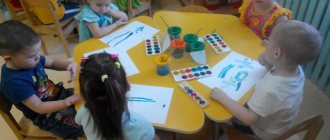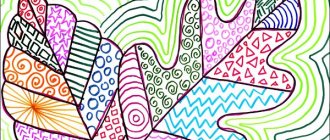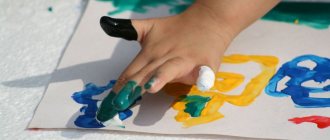Festival of soap bubbles and balloons in kindergarten in the younger group. Scenario
Scenario for summer fun for younger preschoolers.
Celebration of balloons and soap bubbles in the younger group. Author: Natalya Andreevna Kozlova, teacher and educational psychologist, MBDOU d/s No. 7 “Kolosok”, Petrovsk, Saratov region. Duration of the holiday: 20-30 minutes Age : 3-4 years Musical accompaniment: Song “Ding-Ding Kindergarten”,
author of words and music is unknown, performer Musical group “CHILDREN’S SONGS”.
Song “Balloons
” (Theater Song Talisman - AIR BALLOONS - (lyrics and music by Petryasheva).
Song “Soap Bubbles”
(“Dance Teacher”).
Equipment: soap bubbles and balloons according to the number of children, 1 basket, toy cat, 1 easel, table, colored crayons, sticks for drawing on the ground, Whatman paper, felt-tip pens, music, camera, 5 hoops, Fairy costume Description of work: This development is designed for children of primary preschool age and is intended for teachers of preschool educational institutions, also this the development may be of interest to music directors, physical education instructors and psychologists. Leisure is designed to be spent on a summer playground. Game exercises, musical accompaniment, productive activities make it fun, interesting and educational. Summer is a time when you can repeat and consolidate the material covered during the school year.It is very good to do this during entertainment and holidays. Entertainment “Festival of Balloons and Soap Bubbles” with games, songs and dances gives children the opportunity to remember and consolidate mathematical concepts, skills in fine arts, develop motor-active activities, develop coordination of movements, and form vocal singing skills. The purpose of entertainment: to create a magical atmosphere and cheer up children. Objectives: 1. Continue to introduce children to new riddles. 2. Strengthen the technique of drawing round objects. 3. Strengthen your knowledge of colors. 4. Fix the meaning of the prepositions for, between, about, near, before, in, under, on. 5. Strengthen the ability to navigate in space. 6. To arouse children’s desire to develop their imagination and imagination in visual arts and creativity in movement. 7. To form the desire to experience a feeling of fun, joy, satisfaction during entertainment and games. Previous work: Learning poems with children. In the morning, the postman brings a letter of invitation to the children in the group to the “Festival of Soap Bubbles and Balloons.” Progress of the event: The fairy meets the children on the summer veranda, decorated with multi-colored balloons.
Fairy: - Hello, guys! Do you recognize me? (children's answers) - Today I invited you to a party of balloons and soap bubbles. Do you love holidays? (children's answers) (Children are placed on the benches of the veranda).
-Look how many balls there are around?
Children : - a lot. Fairy: - How many balls are on the table? Children : - one. Fairy : - What color is this ball? And this one?…. Children : -blue, red, green, yellow, pink, blue, white) Fairy: - Who is it hiding in our basket, is someone moving there? Guess the riddle “At night he doesn’t sleep at all, He guards the house from mice, He drinks milk from a bowl, Well, of course it’s - (cat) Fairy: - Guys, the cat wants to play. He will jump, and you say where the cat is? ( children's answers
- on the ball, behind the ball, under the table, in front of the ball, in the basket, near the table, between the ball and the basket) - Correct.
Well done boys. Fairy: - And now, I suggest you guess the riddle (Author: Anatoly Khrebtyugov). We inflate them, light and beautiful, in very bright tints, through a tube and release them into freedom. Children: - Soap bubbles Fairy: - Let's listen to a poem about soap bubbles. 1 Child: If you blow harder, there will be a lot of bubbles! One, two, three, four, five, You can never catch them (L. Gulyaeva) Fairy: - Guys, let's play with soap bubbles. I will blow bubbles, and you blow and catch them. And then vice versa.
The song “Soap Bubbles” (“Dance Teacher”) plays (I blow bubbles, the children blow on them) Fairy: - And now, I suggest you guess the following riddle (author: Dima Loginov) We can inflate it quickly. We can let steam into it. He won't fly very low. His name is balloon... (balloon!) Fairy: - Let's listen to a poem about balloons. 2 Child: I have a balloon. It’s bright, light and obedient. When I go for a walk, I hold the ball by a thread. I really feel sorry for Sharik, why is he losing weight? (N. Vysotin) 3 Child: My light balloon Pulled the thread disobediently, broke it off, said: Bye! And rushed off into the clouds. (T. Efimova) Fairy: - Do you want to draw the balls themselves? Children: -Yes. The song “Balloons”
sounds (lyrics and music by Petryasheva)
(Children draw on an easel with crayons, on wet sand, and on whatman paper).
- Guys, do you want to play with the ball? I’ll hide it now, and you will look for it. Close your eyes.
Game "Find the ball."
(I hide the ball in different corners of the area. The children eventually find the ball
). - And now we’ll play our favorite games.
Game “Bubble” Game “Take a Hoop”
Fairy: - Do you want to play and dance with balloons? (Yes) The song “Ding-Ding Kindergarten” the author of the words and music is unknown, the performer is the Musical Club “CHILDREN’S SONGS” (Children dancing with balls). Fairy: “We had a fun holiday.” Did you guys enjoy playing with bubbles and balls? Everyone: - They clapped their hands together, stamped their feet together! Everything we played here, We remembered with you! “Goodbye” everyone said, Let's go home! Fairy: - As a keepsake of our meeting, I give you balloons. Goodbye, see you again!
We recommend watching:
Scenario of summer entertainment for children of the second younger group Scenario of summer entertainment for children of primary preschool age Scenario of summer entertainment for kids in kindergarten Thematic entertainment for children of primary preschool age. Scenario
Similar articles:
Scenario for outdoor fun in summer in kindergarten. Junior group
Drawing "Beautiful balloons"
Construct of joint educational activities
according to PM 02 Organization of various types of activities and communication of preschool children
retraining 700 hours
Matveeva Yulia Petrovna
Group:
Second junior group
Type of OD:
drawing
Subject:
"Beautiful Balloons"
Educational area:
artistic and aesthetic development, cognitive, social and communicative development
Forms
: Front
Target:
Formation of skills to draw round objects.
Planned result:
Children are motivated and take an internal position towards the upcoming activity.
Children have created a visual image of balloons
Children have an idea of the way to draw balloons
Children are relaxed, rested, ready for further activities
Demonstrate knowledge of how to draw a ball
Children can draw balloons.
Children can draw round objects
Children know how to work with paints
Children can place the balls on the entire sheet of paper.
Children are able to compare their work with a model.
Children enter into dialogue with the teacher and answer questions posed
| TASKS educational program | Tasks taking into account the individual characteristics of group students |
| Educational : Foster independence, accuracy Developmental: Develop a desire to draw Educational : figurative: Teach children to draw balloons technical: Teach children to draw round objects color: Teach children to work with paints compositional: Teach children to place balls on an entire sheet of paper | Look at the program and match it with a specific child 3-4 |
Principles of preschool education (FSES DO):
building educational activities based on the individual characteristics of each child, in which the child himself becomes active in choosing the content of his education, becomes the subject of education;
assistance and cooperation of children and adults, recognition of the child as a full participant (subject) of educational relations;
supporting children's initiative in various activities;
formation of cognitive interests and cognitive actions of the child in various types of activities;
age adequacy of preschool education (compliance of conditions, requirements, methods with age and developmental characteristics);
Principles of education:
formation of a personal style of relationships with peers and teachers; creation of a positive emotional background and an atmosphere of emotional uplift; education through interaction
Principles of training:
principle of accessibility, principle of visibility, principle of strength of knowledge
Drawing balls in the middle group
Summary of GCD for drawing in the middle group.
Topic: “Colored balls (round and oval)”
Target:
learn to depict oval-shaped objects - balloons. Program content. Continue to introduce children to the techniques of depicting oval and round objects; learn to compare these forms, highlight their differences. Learn to convey the distinctive features of round and oval shapes in a drawing. Practice your ability to paint by lightly touching the pencil to the paper. Cultivate the desire to achieve good results.
Materials
: a toy - a bear cub, round and oval balloons, colored pencils, album sheets for each child.
Organizing time
.
The teacher invites the children to gather in the play area on the carpet.
Educator:
Guys, guess the riddle:
He is brown and clubfooted, He catches fish with his powerful paw. And he also loves honey! Who will call the sweet tooth? (Bear)
Expected children's answer:
bear
Educator:
Today I invited the little bear to come visit us, but he still doesn’t come. Where did he go? (A roar is heard and a bear cub appears.)
Educator: Little bear, what happened?
Teddy Bear
: I was walking along a forest path and I was bringing you a gift, balloons. He tripped and fell.
Educator:
Bear, you must have been in a lot of pain?
Teddy bear:
Yes, it’s not a problem, but one of my balloons burst. The bear is crying (the teacher imitates it)
Educator:
Little bear, don’t cry, the guys and I will now figure out how to help you.
Educator:
Guys, how can we calm the bear cub down and cheer him up?
Expected children's answer:
We need to buy him a new balloon.
Educator:
We won’t be able to buy him one now, but we can draw new balls for the teddy bear! Let's?
Expected children's answer:
Yes, let's do it.
Educator:
Little bear, don’t be sad, the guys and I will draw you new balloons. (The teacher invites the children to go to the tables where paints, brushes, landscape sheets of paper, sippy cups and paper napkins have been prepared in advance.) The teacher invites the children to look at the image of balloons.
Educator
: Guys, what shape is the ball? (round, oval)
The teacher invites the children to outline this shape in the air with a movement of the hand and demonstrates the drawing technique. The teacher shows the technique of drawing an oval with pencils, accompanying the words with the direction of movement: “round, long shape, again round and again long shape.”
Educator:
Guys, before we start drawing, let's play a little, show the little bear how we can play with our fingers:
Finger gymnastics “Pies”
Here we have kneaded the dough, ( Bend and straighten your fingers
.)
They crushed, crushed, salted. ( We make movements as if we were salting
.)
Chopped into pieces ( We wave with the edge of our left hand, as if we were chopping with a knife
.)
And they made pies. ( Two palms touch each other, one on top, then the other
.)
What a delicious pie! ( We intertwine our hands and pretend that we are trying the pie
.)
Help yourself, my friend!
After finger gymnastics, children do the work independently. The teacher monitors the children’s work and provides assistance to those who are not doing well.
After finishing the work, the teacher invites the children to attach the finished drawings to the magnetic board.
Educator
: Little bear, look what wonderful balls the guys have drawn for you.”
Teddy bear:
Oh, what beautiful balloons you made, guys! Thank you very much!
At the end of the lesson, the teacher asks the children what they did today? What did you draw? What shape are balloons? What color were the balloons? For whom were the balloons drawn?





